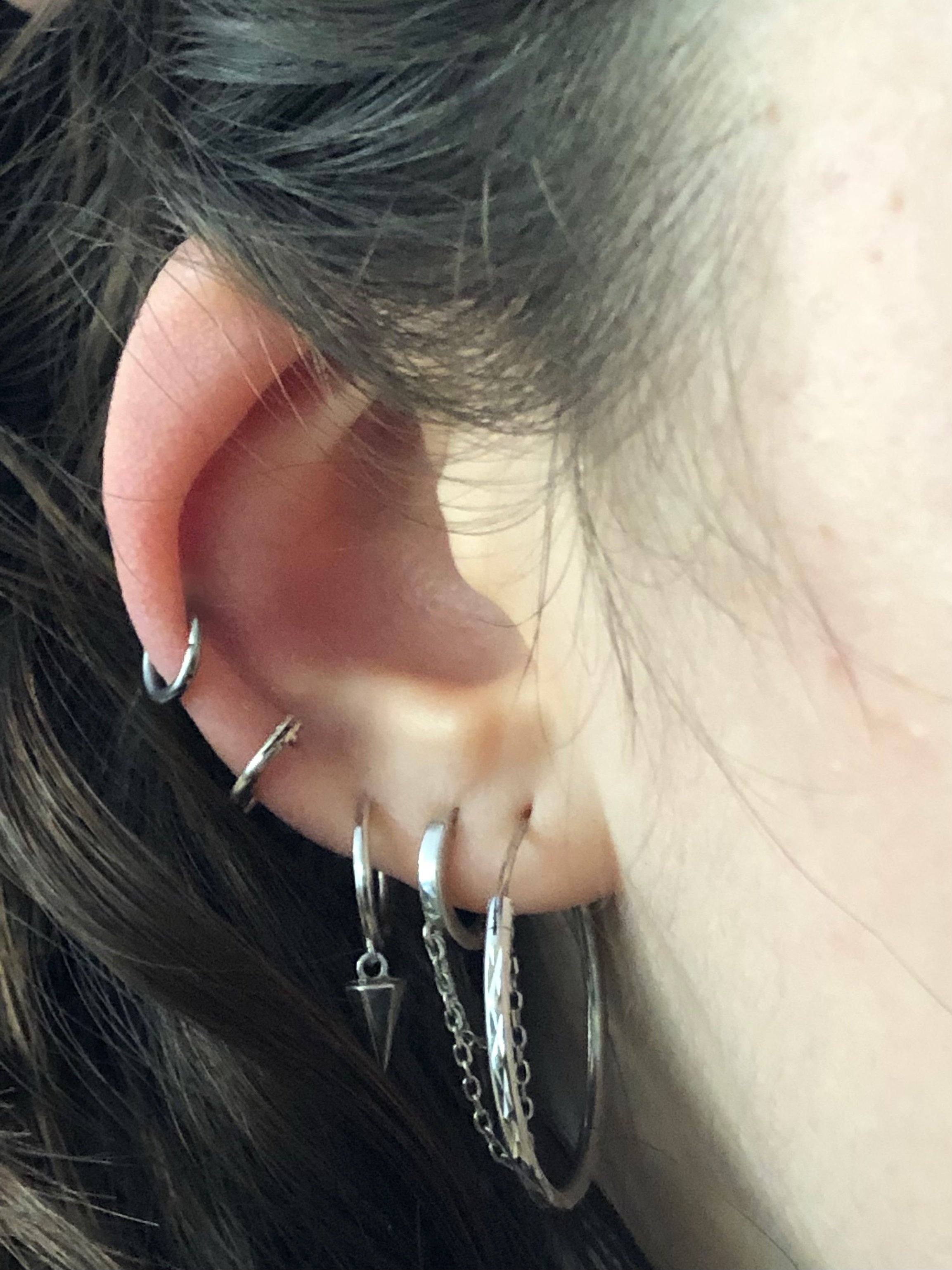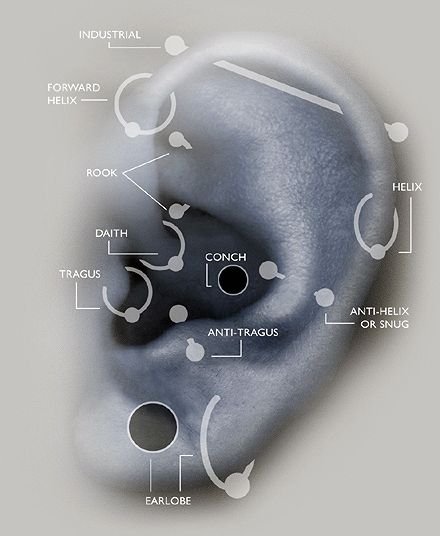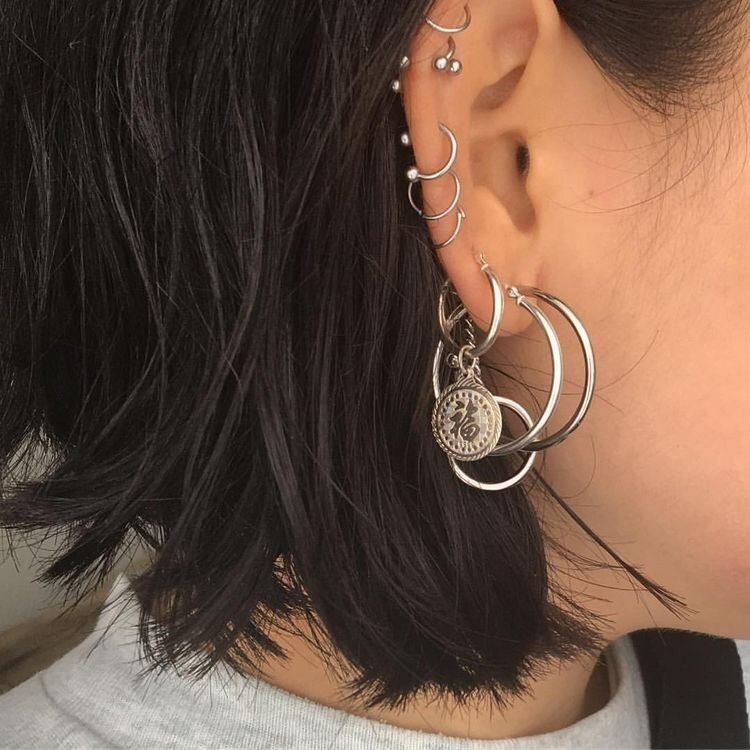At age 6 or 7, my mother took me to a piercing kiosk at the mall to get my first ever ear piercings. They were, unsurprisingly, one earring on the lowest part of each earlobe. For years thereafter, I adored going to Claire’s and buying funky earrings of all kinds to show off at elementary school. I grew old and realized that you could actually get more than one piercing on each ear. In middle school, I begged my mom to let me get second lobe piercings, and eventually she caved. We went back to the same piercing kiosk at the mall and I got two jeweled studs punched into my ears with a piecing gun.
But, my obsession was not quenched with just four piercings. Before I turned 18, I wanted multiple piercings so badly that (DO NOT TRY THIS AT HOME!) I used a safety pin to give myself three new ones on my lobes. It was when I was 15 years old, beginning with a third lobe piercing on my left ear, and eventually a third lobe piercing on my right ear. When I was 16, I continued by giving myself a fourth lobe piercing on my right ear. As I did not have much lobe space left and my parents were not pleased at my self-inflicted body modifications, I waited until I was 18 to continue getting pierced.
Between September 2020 and March 2021, I got three new ear piercings professionally done. I had my upper left helix, my middle right helix, and my left rook pierced at a tattoo and piercing establishment in my home town. In case you have lost track, that totals to 10 piercings between both of my ears. After enduring all of this, as well as having my initial jewelry changed by the same piercer, I consider myself a seasoned piercing-receiver. Below, I will give you a step-by-step process of what you should do before getting pierced, so I can vicariously relive the experience while I am waiting until after my wisdom teeth surgery in December to get my nose pierced. (Mom, if you’re reading this, sorry :/)
Ear piercing anatomy. Image via Pintererst.
Think About It
Now you may ask, what went into the process of getting my piercings? Well firstly, as you read above, I considered the piercings for a very long time. I was interested in getting them for multiple years, and also considered each piercing placement specifically for multiple months before booking an appointment. Piercings are, for the most part, a lasting modification to your body and should be seriously thought over before you get one. The stereotype of getting piercings as a spontaneous act is not only partially false, but is also a dangerous stereotype that may lead to you making a drastic decision before thinking it through. Though depending on your body a piercing may close up even after having the jewelry in for years, piercings are essentially permanent.
I have been interested in getting a nose piercing since at least early high school and have been seriously considering it for about 6 months. Now that I feel comfortable and confident with the idea, I will eventually make an appointment to get pierced at my regular studio at home.
Avoid Amateur Piercing Establishments
Once you have decided you are interested in getting a piercing, the next step is to look for a reputable, highly rated piercing establishment. DO NOT GO TO CLAIRE’S (or a mall piercing kiosk). Not only may these piercers not be professionally trained, but Claire’s and other amateur piercing places use piercing guns instead of hollow needles, which is an improper way to perform body piercing. A piercing gun used blunt force trauma to force the jewelry through the skin and cartilage, rather than the hollow needle which smoothly creates an opening without trauma that allows jewelry to be inserted properly. Piercing needles will ultimately yield more accurately placed piercings and facilitate the healing process.
I did lots of research on body piercings before getting my first professional piercing. Therefore, I knew to avoid these amateur establishments and places that use piercing guns. This launched my search for a professional tattoo and piercing studio in my area.
Image via iStockPhoto.
Search for a Reputable Piercer in Your Area
Once you rule out Claire’s and the sketchy mall kiosk, begin to look for piercing and tattoo studios in your area using Google, Yelp, and other customer review platforms so you can be informed of the quality of their services as well as the cleanliness and conditions in the studio. Read through essentially every review you can find to get an idea of people’s experiences here, both positive and negative. If you see the name of a specific piercer being recommended multiple times, think about scheduling your appointment with that piercer.
Upon searching through different tattoo and piercing studios near me, I thoroughly read the reviews of one that interested me before getting my first helix piercing. The studio had overwhelmingly positive reviews and I decided this is where I wanted to get my piercing. I have had every piercing since done at this same studio, and am planning to go to the exact same piercer from my two previous piercings to get my nose pierced.
Image via Pinterest.
Visit the Studio or Schedule a Consultation
Oftentimes, consultations are required before getting a tattoo. Though they are not often required before getting a piercing, calling the studio, scheduling a consultation, or walking in to check out the environment and speak with the staff can be a very informative way to narrow down the studio you would like to get pierced at. You can see the conditions and speak with the person who may be piercing you later. Pay attention to the cleanliness, friendliness, and openness in the studio. If you catch any red flags, look for a different studio.
This is a step that I did not take before my first piercing at my studio, but I really wish I had. When I first arrived for my helix piercing in 2020, I was already nervous, and being in a new environment exacerbated that. I would recommend that getting acquainted with the surroundings in which you will be pierced beforehand can keep you calm for the piercing process. Now that I am better acquainted with the studio and the staff, I feel much more comfortable being pierced there.
Image via Pinterest.
Schedule a Piercing Appointment
A studio will likely have the option to schedule an appointment by phone or online. I highly recommend scheduling an appointment rather than going spontaneously, because it gives you even more time to consider and reconsider the placement of the piercing and the decision to get pierced in general. Choose a day and a time of day where you will not be busy or stressed. It is important to be calm and have a clear head, and allow time in case you faint, are hesitant, or the studio is running late.
I always schedule my appointments ahead in order to feel more organized and prepared. Also, since my regular piercer is in my hometown, I tend to schedule my appointments over breaks from school when I am the least stressed and have the least amount of commitments.
Preparing for the Appointment
As mentioned earlier, select the type of piercing (helix, rook, conch, navel, etc.) before your appointment, and then choose the exact location you would like in that spot so you are prepared to tell your piercer. Before your appointment, make sure to eat some food, drink water, and get a good night’s sleep. You want to be feeling your best, especially if you are nervous about the pain or are afraid of needles. Do not get pierced under the influence, even if you think it will help numb you and calm you down. A good piercer will tell you to reschedule if you show up to your appointment intoxicated. Save the painkillers until after you are pierced. Medicines like Aspirin thin your blood and may cause you to bleed more when pierced.
Having nerves are normal! But if you feel extremely nervous or anxious, you should probably hold off on getting your piercing. If you would feel reassured by having a friend or family member with you, arrange someone to accompany you on the day of the appointment. Some piercers may not let them come into the back of the studio with you, but they will be there in case anything happens. At my piercer, I was waiting for an appointment and a girl fainted while getting her nose pierced. The piercer was extremely attentive, calm, and caring when this happened and the girl’s boyfriend was waiting in the lobby for her the whole time. The studio should feel like a safe space anyways, but you can feel extra comfortable by bringing someone else.
Image via Pinterest.
What Happens When You Get Pierced
After you tell your piercer what kind of piercing you want, they will help you pick out your jewelry, and then they will prepare to pierce you. If you see a piercing gun, run. Do not be afraid to back out if you notice improper piercing technique like this. Any ear or body piercings should be performed with a sterile, hollow needle. Good piercers will explain each and every move they make before they pierce you. They will wash their hands and put on new, sterile gloves (let them know beforehand if you are allergic to latex). They will demonstrate that they are taking the equipment out of new packages, indicating that it is clean and unused. Next, they will clean and prepare the jewelry you picked out. The piercer will also likely explain to you the sensations you will feel during piercing if you have never received one: the pressure of the clamp that is holding the pierced area steady; a swift, initial pinch when the needle is inserted; the pressure when inserting the jewelry through the other end of the needle; and the feeling of the jewelry being closed, screwed on, etc. Pain levels and discomfort will of course vary between piercings and between people. They may also ask you to lay down in case you faint or get dizzy.
My piercer both demonstrated the preparation of the sterile equipment and cleaning the jewelry while explaining the piercing process in depth. Good piercing practice like this made me feel very reassured, calm, and safe before being pierced. It also backed up their reputation as a trusted piercing establishment. I personally found being professionally pierced to be less painful than when I got my lobes pierced with a gun. In general, the healing process may be more painful than the piercing itself because the pinch is temporary.
P.S., you should probably not be getting a hoop as initial jewelry for any piercing. This will cause the piercing hole to heal curved and can even cause more irritation or a harder healing process. A good piercer will know not to give you a hoop as initial jewelry for a helix, nose, nipple, or any other new piercing. A slight exception is that it is extremely common to get curved barbell jewelry initially for a rook, navel, or eyebrow piercing.
Image via Pinterest.
Aftercare
Though the act of being pierced may seem like the worst part of getting a piercing, it is actually the healing process that can be the toughest. After your piercing, your piercer should give you information on how to take care of the fresh piercing and how long it will take to heal. The healing varies depending on the location, eg. a helix piercing can take between 4 to 12 months to heal. Bumping your jewelry, playing with it, or forgetting to clean it can set back the healing process as well. Many people also develop keloids (bumps made of scar tissue around the piercing site) while their piercing heals. Though unattractive, these are not necessarily signs of infection, but rather irritation than can be reduced by cleaning and taking care of the piercing.
Though there are many recommended methods of cleaning piercings all over the internet (and different advice from different piercers), what I find to personally work the best and cause the least irritation is soaking my piercings in a sterile saline solution. Rubbing alcohol, healing ointment, Vaseline, and other products tend to irritate piercings and curb healing. I also advise against using cotton balls or cotton swabs to clean the piercing, as the microfibers of cotton can get wrapped around the jewelry or trapped in the hole.
When I get a fresh piercing, twice a day for 10 minutes I soak it in a mix of 1/2 cup of water and 1/8 teaspoon of salt, which I microwave to a comfortably warm temperature. I try to avoid touching, playing with, bumping, or rolling onto my new piercing. The piercing site will be tender, red, or swollen for a few days after piercing. A new piercing (and old one sometimes) will develop a crust around the hole, which is a normal way of the body cleaning the wound. The warm saline solutions will loosen and clean these crusts without you having to touch the piercing.
I also like to buy a sprayable saline solution (like H2Ocean or a saline wound wash) that I can spray on my piercing throughout the day or when it gets irritated and I do not have time to soak it. If you are extremely careful with your new piercing and keep up your habits of soaking it, you will have an unproblematic new piercing. If you are concerned at all that your piercing is infected, being rejected, migrating, or you are allergic to the metal, visit your piercer or your doctor as soon as possible, and they will advise you on what to do from there.
Image via Pinterest.
Changing Jewelry
You should wait until your piercing is completely healed before changing your jewelry or having your piercer change it. This means no bleeding, redness, irritation, infection, etc. I also highly recommend having your piercer change your jewelry for you, as it can be very tricky to remove initial jewelry and you risk damaging the jewelry, irritating the piercing, or getting bacteria in the hole. I waited about 9 months before having my first helix piercing jewelry changed from a barbell stud to a hoop. But, I did have a few special cases where my piercings were not healing well due to the initial jewelry. My rook piercing jewelry was initially a long curved barbell to prevent swelling, but it was changed after a few months to a shorter curved barbell, which helped the healing. Also, for the helix piercing on my right ear, the piercing was knocked, rolled on, or caught on fabric or my hair much more often because of how my right ear protrudes slightly compared to my left ear. As it was healing poorly, changing from a stud to a hoop also facilitated the healing process. My piercer performed each of these jewelry changes.
Image via Pinterest.
Conclusion
Though piercings add quite an edge to your look, they are neither spontaneous nor easy. A lot of thought should go into selecting a piercing and a piercer. You should pay close attention to the conditions and attitude of your piercer before going through with the piercing. Aftercare is a lengthy and difficult process compared to the brevity of being pierced, and having a piercing is a big commitment. Despite the work and hassle that often comes with planning and taking care of a piercing, I have always found it to be worth it in the end. Piercing are a beautiful and personal addition to anyones body and I highly recommend the process for anyone that is interested.
Featured image via Pinterest.









